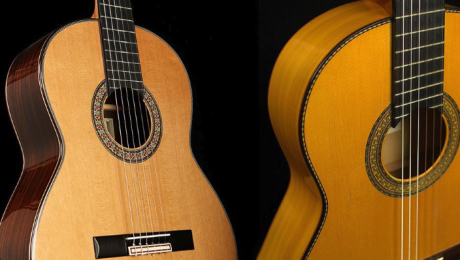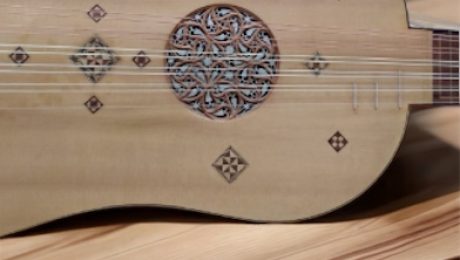When looking for a nylon string guitar, should I get a classical or a flamenco guitar?
The choice between a classical guitar and a flamenco guitar depends on your musical preferences and playing style.
Both types of guitars use nylon strings, but they have distinct differences in terms of wood tone, sound, construction, and playability.
The Classical Guitar:
Classical guitars are known for their warm and rich tone. They have a well-balanced sound with a strong emphasis on the bass notes, and due to the stiff back and the sides, they have longer sustain.
Classical guitars may have a wider neck and a slightly deeper body than flamenco guitars. This design contributes to their balanced tone, projection, and longer sustain.
Classical guitars are often preferred for fingerstyle, classical music, and genres requiring precise fingerpicking and complex chord work.
The Flamenco Guitar:
Flamenco guitars are designed to produce a bright and percussive sound. They have a more pronounced attack and emphasize the treble frequencies.
The Flamenco guitars usually have a thinner body and a slightly narrower neck than classical guitars. This design allows for quicker and more dynamic playing.
Flamenco guitars are especially suited for Flamenco music, a genre that involves rapid strumming, tapping, and percussive techniques. They are also versatile for other styles like Bossa Nova, Brazilian Jazz, Jazz, folk, and certain types of world music.
Conclusion:
Ultimately, the choice between a classical and a flamenco guitar should be based on the style of music you intend to play, and YOUR playing technique. If you’re primarily interested in playing classical compositions or favor a mellow tone, a classical guitar might be the better choice.
On the other hand, if you’re drawn to the lively and percussive sounds of flamenco music or enjoy more energetic styles as mentioned above, a flamenco guitar could be the right fit.
It is strongly recommended that you try out both types of guitars in person, if possible, come to our studio in Boca Raton -Florida, and spend a few hours until you find a Guitar that “talks back to you” Then, you will not be able to put it down.
- Published in Blog
The Vihuela and the Classical Guitar
The Vihuela and the Classical Guitar
The vihuela is a plucked string instrument that originated in Spain during the 15th century. It belongs to the lute family of instruments and played an important role in the development of Renaissance music and the Classical Guitar.
The early vihuelas were typically small instruments with a rounded body, similar to a guitar, and featured a flat back and a sound hole. They had six double-string courses, meaning each course consisted of two strings tuned in unison or octaves. The strings were made of gut, and the instrument was played by plucking the strings with the fingers.
Vihuelas were commonly used to accompany vocal music and played as solo instruments. The Spanish aristocracy favored them and was often associated with courtly and secular music. The vihuela’s popularity reached its peak during the 16th century, particularly in the region of Spain known as Castile.
The music composed for the vihuela was usually written in tablature notation, a system that indicates which strings to pluck and where to place the fingers on the fingerboard, very similar to today’s TABS. Many renowned composers of the time, such as Luis de Narváez and Alonso Mudarra, wrote music specifically for the vihuela.
Over time, the vihuela underwent changes in its design. The instrument became larger, with a more elongated body and an increased number of courses. By the end of the 16th century, some vihuelas had up to seven or eight courses of strings.
However, as the Baroque period approached, the popularity of the vihuela declined. It was gradually replaced by the guitar, which offered more versatility and a wider range of musical possibilities. By the 17th century, the vihuela had largely fallen out of use.
In modern times, there has been a revival of interest in the vihuela. Today, there are musicians and luthiers dedicated to reconstructing and playing this historical instrument. They study historical treatises and manuscripts to recreate the authentic sound and playing techniques of the vihuela.
The vihuela’s historical significance lies in its role as a transitional instrument between the medieval period and the Renaissance. It played a crucial part in shaping the development of music during that era and holds a special place in the history of Spanish music.
- Published in Blog
Fan Bracing top vs Lattice Bracing top
Fan Bracing vs Lattice Bracing top
By luthier Marcus Dominelli, Victoria, BC, Canadá.
Fan Bracing top
Antonio de Torres (1817–1892) is generally given credit as the father of the modern classical guitar. He radically redesigned the instrument, giving it a larger body, lighter bracing, and a thinner soundboard than did his predecessors.
The bracing pattern is shown here, or slight variations of it, is the most widely used pattern in the classical guitar since the time of Torres. It is now commonplace, but 150 years ago it was truly revolutionary.
You can see from the picture how the braces are now running more in the direction of the soundboard grain, and not perpendicular to the grain like in the lute and many of the early 19th century guitars such as those made by Lacote.
This change in brace orientation is significant to the musician. Combined with the larger body and the thinner soundboard, fan bracing makes for a warmer, earthier sounding instrument with a much stronger bass response than the ladder braced guitars of the early 19th century. Simply put, Torres’ guitar had a greater dynamic range of tonal possibilities and was a more versatile tool for making music.
Lattice Bracing top

In the late 1970s, an Australian guitar maker named Greg Smallman popularized the lattice braced guitar. It was truly revolutionary, and his guitars to this day can be found in the hands of many of the world’s finest players. The basic physics behind how the lattice works is very simple:
Since a lattice structure is inherently stiff both with the grain and across it, the soundboard can be made much thinner and still be strong enough to withstand the string tension, thus substantially reducing the total weight of the top. The energy of the strings is more efficiently transmitted into soundboard vibration, the net result being a guitar with greater volume, and faster string response.
Another benefit of Lattice bracing is greater ease of playability and dynamics. By dynamics, I mean the ability of the guitar to respond to both aggressive and gentle right-hand techniques.
Playability is more than simply a function of adjusting string action at the nut and saddle. Although string height influences on playability, how the soundboard responds to every subtle nuance of the strings and hands is probably more important to the musician than action height alone.
- Published in Blog
How to care for your guitar.
Your guitar is made of organic matter, susceptible to changes in temperature and humidity. Wood is always in motion, It contracts and expands. In addition, it will absorb external particles such as mineral salts, smoke, sweat, and other elements.
How to care for your guitar.
1.- Do not subject your guitar to sudden changes in temperature, always travel with thermal cases, and never, but never leave it under the sun, air conditioning, or heating.
2.- To avoid Cracks, and” frets growing” the ideal percentage of relative humidity should be between 40% and 65%.
3.- Replace your strings before you feel they are “Dead “, your guitar will get used to those lower vibrations and will never reach its full potential.
4.- Change your strings one by one. Avoid the sudden loss of tension in the bridge and the top.
5.- If you are going to travel by plane, loosen the strings a bit and never check it in without having a suitable case.
6.- Clean the strings every time you finish using them, you will increase their useful life and prolong their shine.
7.- Clean your guitar with a microfiber cloth, or use a lightly damp cotton cloth. Use ONLY approved cleaning products that leave a protective barrier against sweat and dust.
8.- We recommend using protective lenses for at least 6 months after your guitar was built to avoid damage to the varnish.
9.- Oiling the machinery once a year if necessary. Make sure to dry the residual oil.
10.- If you are not playing for a while, leave it IN the case, and close it properly. You don’t want your guitar “flying” when picking up the case!!??
If you have any questions please contact us at info@GFSflorida.com or visit our page at https://guitarsfromspain.com/
- Published in Blog
Which are the best strings for my guitar?
By Alejandro Gonzalez from Encordando.
WHICH ARE THE BEST GUITAR STRINGS?
WHICH STRINGS DO YOU RECOMMEND THE MOST?
WHICH STRINGS LAST THE LONGEST?
These are undoubtedly the most common questions regarding guitar strings. The ideal strings depend on many factors such as:
Your ideal sound
Your anatomy (nails, fingers, and hands)
The filing you use.
Your technique.
Your guitar.
The repertoire you play.
The environment (climate, sound) where you are going to play, etc.
To help you choose your ideal strings we included the factors to consider in two large groups:
Characteristics of the string: tension, materials, specific sound of the brand or model.
External factors: Guitarist, Guitar, Stage, Weather, Repertoire, etc.
SPECIFIC CHARACTERISTICS OF THE STRINGS
MATERIALS
There are practically 3 types of treble: Nylon, Carbon, and Titanium.
Nylon is the ideal material for all those looking for an intimate, round, sweet, and warm sound, it tends to have more body and allows a greater tonal range to be handled. As the material is less tense, it is softer to the touch, more compliant with the left hand (or right hand for lefties), less abrasive with the nails of the right hand (or left hand for left-handed) and allows better (and easier) vibratos, portamentos, “bendings” and Bartok pizzicato.
Carbon (Fluorocarbon) undoubtedly gives more power and brilliance; they have much greater projection and volume. The sound, especially the harmonics, generates a more homogeneous sound across the fingerboard than Nylon strings, especially on the third string. You can check this by comparing the G of the ( E ) first string at the 3rd fret with the G of the third-string 12th fret. If the strings are made of Nylon there is a lot of difference in the sound, Carbon is a denser material than Nylon, resulting in a thinner gauge, harder, tighter, and less flexible strings. They have greater tuning stability once they “settle” (although they take longer to settle) and tend to be more durable. Titanium is a type of polyamide very similar to nylon, but with a modified formula that gives it special tonal characteristics, enhances the high tones producing a more crystalline and brilliant sound, noticeable especially in the third string, sounding less like plastic than in the most Nylon strings. Overall, it is in the middle of the characteristics between nylon and carbon.
ABOUT THE BASS It is more difficult to define the type of sound you get based solely on the material for two simple reasons: They are made of several different materials and consist of several parts: core, wound, and cover Manufacturing procedures vary between brands and even between models of the same brand, so the resulting sound ends up also varying. Most basses feature a Nylon multifilament core with a mostly silver or copper wound, although there are many other metals that can be used in alloys for the various bass models available today. Regarding the material, the only thing that is 100% clear is that the coating that they add to some models to protect the string from oxidation. Our sincere recommendation would be that you try as many basses as you can until you find one that works best for your guitar and for you.
TENSIONS & GAUGE We know that there are too many tension options: extra low, low, normal, high, extra high, medium / high, etc … they are not standardized measures, but rather each makes names them, differently. For example, a “normal” tension string of brand X may be tighter than some “medium / high” tension rope of brand Y. Tension is directly related to gauge (the diameter of the string in a cross-section). The higher the gauge, invariably the greater the tension required to tune the string to a certain pitch. HIGH TENSION STRINGSThey require more finger pressure when playing which means that both hands can tire you more. They produce greater volume and greater projection but require more energy. They are of higher gauge, which implies more mass and results in a duller sound than strings of lower mass/gauge/tension. There is the possibility of further wear out the nail. In virtuous passages, they give the sensation of greater speed and control in the right hand. They can cause damage to the bridge in delicate instruments. MEDIUM OR LOW TENSION Greater risk of causing disruption, lower volume, and projection. It is easier to use techniques such as legato, vibratos, capos, glissando, etc. The “sustain” is greater, especially in piano mezzo-forte passages.Less wear on the nail. Easier and more comfortable to play in general. Ref- EnvironmentWe refers to the climate (temperature and humidity) and the sound (acoustic) of the place where you are going to play. We recommend that you take into account the environment where you are going to play at, to choose your strings.
Humidity changes the density of the air. The higher the percentage of air humidity, the more your guitar top will absorb part of that humidity. The top becomes heavier and dense. it moves with greater difficulty, that ends up producing a more muffled sound, without brilliance. We have found that in humid climates high tension strings are more conducive to sound as they transmit more energy to the instrument
Temperature also affects, the warmer the climate, the greater the speed of sound propagation we will have. This means that in warm or temperate climates it will be easier to fill large rooms with low projection strings ( Nylon and/or medium-low tensions) and it will be easier to fill large rooms with carbon strings or high tensions in cold climates. The combination of these three variables: humidity, temperature, and particular acoustics, greatly influence the final sound result, they can determine how much you hear yourself when playing, how well listeners hear you, and even how easily you achieve a good concentration. when interpreting any work. Normally we call the mixture of these three factors, with somewhat subjective terms, such as “dry” scenarios, with a lot of “reverb” or “with very good acoustics”, as in some old stone churches or theaters with good acoustic design for the guitar.
CONCLUSION: Try different brands, materials, and tensions. The options are many, but you must be aware of choosing a suitable string for the circumstances and guitar you are playing in, as this will dramatically change your guitar sound.
If you have any questions, please contact us at info@GFSflorida.com or visit our site https://guitarsfromspain.com/
- Published in Blog






